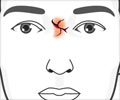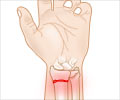Both minimally invasive and traditional open approaches can successfully repair nasal fractures, provided the procedure is matched to the individual fracture.
Both minimally invasive and traditional open approaches can successfully repair nasal fractures, provided the procedure is matched to the individual fracture.
The report appears in the September/October issue of Archives of Facial Plastic Surgery, one of the JAMA/Archives journals. A treatment algorithm based on factors such as fracture type and degree of septal deviation (displacement of the bone and cartilage separating nostrils) may help surgeons choose the appropriate treatment.Nasal fractures are common, but treatment of these injuries remains controversial among surgeons, according to background information in the article. Some recommend no intervention at all, whereas others favor extensive open surgery using rhinoplasty techniques. Treatment is typically divided into closed reduction (minimally invasive repair) or open reduction techniques. "Closed reduction is a relatively simple procedure, at times producing acceptable outcomes," the authors write. "However, advocates of open reduction purport better cosmetic results and a high likelihood that closed reductions will eventually need a second operation using an open reduction technique."
"Deciding which technique to use for a given nasal fracture can be challenging. Not all fractures can be treated using closed techniques and, conversely, not all fractures require the time and expense of an open reduction," they continue. Michael P. Ondik, M.D., and colleagues at Penn State Hershey Medical Center, Hershey, Pa., studied 86 patients who received treatment for nasal fractures (41 who had closed treatments and 45 who had open treatments) at the facility between 1997 and 2007. Fractures were classified as one of five types, revision rates were calculated for each group, pre- and post-operative photographs were rated and available patients were interviewed about aesthetic, functional and quality of life issues.
The revision rate for all fractures was 6 percent, including 2 percent for closed treatment and 9 percent for open treatment. Many closed treatment cases were classified as type II fractures, or simple fractures that included septal deviation, whereas most open treatment cases were classified as type IV fractures (severely deviated nasal and septal fractures). "There was no statistical difference in revision rate, patient satisfaction or surgeon photographic evaluation scores between the closed and open treatment groups when fractures were treated in the recommended fashion," the authors write.
A treatment algorithm that considers fracture type, whether the fracture is impacted (in which bone fragments are wedged together) or incomplete, the degree of septal deviation and whether previous treatments have failed could help surgeons determine the best approach to each individual fracture, the authors note.
"A successful management algorithm should provide each patient with an aesthetically and functionally superior repair, leaving the most invasive repairs for only those patients who require it and allowing simple fractures to be managed relatively conservatively. Our results validate this approach and effectively 'even out' the outcomes between the open and closed groups," they conclude. "We believe that our classification system and management algorithm represent a new paradigm in nasal fracture management."
Advertisement
ARU














